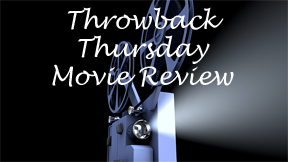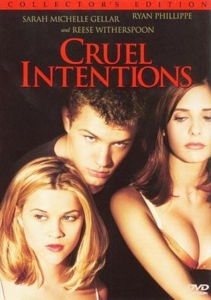1999 was a landmark year for movies and TV, so we’re being bombarded by 20th anniversary celebrations of these classics. But is “Cruel Intentions,” from March 5, 1999, one of those classics? I saw it in the theater when it came out and didn’t like it, but in all honesty about 90 percent of the reason is that I couldn’t handle seeing Buffy as a bad person. Giving it a fresh look today, I can see why people celebrate this film – and besides, at least Sarah Michelle Gellar distances herself from her iconic role by having brown hair here.
Updated for the Nineties
“Cruel Intentions,” an update of the 18th century French novel “Dangerous Liaisons,” is a delicious time capsule of the young stars of the era, including Gellar, Ryan Phillippe, Reese Witherspoon, Selma Blair and Sean Patrick Thomas.
Appropriately, they all play rich teens who are on top of the world, with hardly an adult in sight as they play grand sex and manipulation games throughout posh apartments on the Upper East Side. “Gossip Girl” would later tap into this vibe, and there was almost a “Cruel Intentions” TV series (twice) and there was indeed a prequel and a sequel film made.

“Cruel Intentions” (1999)
Director: Roger Kumble
Writers: Choderlos de Laclos, Roger Kumble
Stars: Sarah Michelle Gellar, Ryan Phillippe, Reese Witherspoon
But it’s hard to imagine this story playing out beyond the 100-minute mark. Even within the movie’s framework, you almost need a scorecard to keep track of everyone, and what everyone’s view is of everyone else, and how that contrasts with who they really are.
For example, Gellar’s Kathryn is beloved in her social circle, but not based on anything genuine. She works so hard at image-making that one wonders if it would be easier to just be a good person. That’s the nature of the tale, though, wonderfully unspooled by writer-director Roger Kumble.
“Cruel Intentions” is stylized, but I get the sense that this type of interplay could happen, at least to some degree. Kathryn and her player stepbrother Sebastian (Phillippe) make a bet that he can successfully bed Annette (Witherspoon), a dedicated virgin. If she wins, she gets his vintage car; if he wins, he gets to have sex with Kathryn, the only woman he hasn’t been able to conquer.
Thin line between hate and love
As Sebastian works his game on Annette, he finds she’s a tougher nut to crack than he’s used to, and he gradually falls in love with her. “Cruel Intentions” is an incredibly racy movie (the practice kiss between Kathryn and Blair’s Cecile is iconic), but at its core is the old-fashioned notion that love blossoms if sex is postponed.
It can certainly be argued that the Sebastian-Annette relationship is unbelievable (or highly stylized, to use a kinder assessment). Almost every conversation we’re privy to finds Sebastian arguing why they should be together, and Annette arguing why they shouldn’t be. When do they learn anything else about each other? Still, it is fascinating when Sebastian returns home and has tete-a-tetes with Kathryn – who can read Sebastian quite well.

The most entertaining performance, I was surprised to find on this viewing, comes from Blair as a new student at the step-siblings’ school who is in love with her young cello teacher, Ronald (Thomas). It’s amusing how Kathryn and Sebastian hold their noses to deal with this naïve girl who is central to their plans, and for her part, Blair walks a perfect line between Cecile’s sexual awakening and hilarious naivete – absolutely nailing several pratfalls, which are incongruous in this posh film and all the funnier for that reason.
The part I remembered most from my theatrical viewing was how The Verve’s “Bitter Sweet Symphony” plays over the villain’s takedown, but I remembered it wrong. In my head, Kathryn walks along the sidewalk in shame, but I got that mixed up with the music video. On this viewing, the conclusion didn’t work as well for me, partly because Sebastian’s demise is staged so unrealistically that I had to watch till the end of the credits to see if he faked his death somehow.
What goes around comes around
Still, I like the message that the cycle of manipulation eventually comes around to bite the manipulator. And if one wants to make a stretch of aural symbolism, it’s fitting that “Bitter Sweet Symphony” samples a song that’s a cover of a song that samples a song. It’s the fourth iteration of a song, in other words — a bittersweet symphony that keeps playing through the generations. Plus, it’s one of those loopy earworms, and we can easily imagine the singer is marching down an endless sidewalk in the music video.
In adapting this story from two centuries prior, Kumble and his team further play up the timeless aspect with analog communication such as hand-written love letters and Sebastian’s journal, which gets photocopied, bound and distributed.
This is openly anachronistic – an opening scene finds Sebastian distributing nude photos of Tara Reid’s character across the internet; that and cellphones clearly indicate it’s a contemporary setting. I like the anachronisms, though. This is one of those cases where I know they’re making a style choice and I like the overall film enough to go with it.
Something that does date “Cruel Intentions” slightly, in a fascinating way, are elements of homophobia and racism. They come from the villains, mostly, and they are intentional, effective choices to get a reaction out of the audience. But I wonder if those elements would be included if the film had been made today, when everyone has been taught to keep their meaner inclinations under wraps. Strangely, the open and casual rudeness of 1999 taps into nostalgic feelings almost as much as seeing the young stars.

